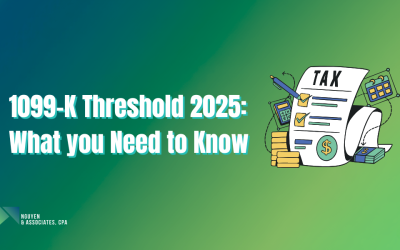The 2025 tax year brings some of the biggest adjustments in years to the federal tax brackets and standard deduction, plus important changes to the child tax credit, payroll tax thresholds, and capital gains bands. These updates apply to income you earn in 2025 and report on the return you file in 2026.
Below is a clear breakdown of what changed, who benefits, and how to use these rules in your planning with Nguyen & Associates, CPA.
Overview: Why the 2025 Tax Updates Matter
The 2025 rules are driven by a combination of IRS inflation adjustments and new federal legislation that locked in the seven tax rates (10%, 12%, 22%, 24%, 32%, 35%, and 37%) and significantly raised the standard deduction for all filing statuses.
For many households, more income will now fall into the 0% and lower brackets, which means less tax on the same nominal income.

At the same time, new bonus deductions and credit rules add complexity. Some taxpayers will see clear savings. Others will see little change, especially if their income is too high for new benefits or already low enough that they owed little federal income tax to begin with.
2025 Standard Deduction: Bigger Shield From Tax
The standard deduction is the amount of income you can earn before you owe federal income tax, assuming you do not itemize. For 2025, the standard deduction is:
| Filing status | 2025 standard deduction | 2024 standard deduction | Change |
|---|---|---|---|
| Single | $15,750 | $14,600 | + $1,150 |
| Married filing jointly | $31,500 | $29,200 | + $2,300 |
| Married filing separately | $15,750 | $14,600 | + $1,150 |
| Head of household | $23,625 | $21,900 | + $1,725 |
The jump is meaningful. For example, a married couple with $90,000 of taxable wages and no itemized deductions will see $31,500 of that income shielded from federal income tax before brackets apply.
Extra Standard Deduction for Seniors and Blind Taxpayers
On top of the base standard deduction, taxpayers who are age 65 or older or blind can claim additional amounts:
- Single or head of household, blind or 65+: + $2,000
- Single or head of household, blind and 65+: + $4,000
- Married filing jointly or separately, blind or 65+ (per person): + $1,550
- Married filing jointly or separately, blind and 65+ (per person): + $3,100
New law also created a separate temporary $6,000 bonus deduction for taxpayers age 65+ that runs from 2025 through 2028. This can stack on top of the existing age and blindness amounts, but it phases out for higher incomes. In broad terms:
- Phaseout begins once adjusted gross income (AGI) exceeds about $75,000 for single filers.
- For married couples filing jointly, the phaseout begins around $150,000 of AGI.
- The bonus deduction is fully gone at higher income levels.
Practically, many middle income retirees will see a large part of their Social Security and modest retirement income fully covered by the higher deductions, while affluent retirees will see only partial benefit.
Upside: More income is taxed at 0%, especially for retirees and middle income households.
Downside: The rules around bonus deductions and phaseouts are more complex, which makes it easier to miscalculate or under-withhold if you do not plan ahead.
2025 Federal Income Tax Brackets
The seven federal tax rates from the Tax Cuts and Jobs Act are now effectively permanent under recent legislation. Bracket thresholds for 2025 have been adjusted, and the structure is:
Single filers
| Tax rate | Taxable income range |
|---|---|
| 10% | $0 to $11,925 |
| 12% | $11,925 to $48,475 |
| 22% | $48,475 to $103,350 |
| 24% | $103,350 to $197,300 |
| 32% | $197,300 to $250,525 |
| 35% | $250,525 to $626,350 |
| 37% | Over $626,350 |
Married filing jointly
| Tax rate | Taxable income range |
|---|---|
| 10% | $0 to $23,850 |
| 12% | $23,850 to $96,950 |
| 22% | $96,950 to $206,700 |
| 24% | $206,700 to $394,600 |
| 32% | $394,600 to $501,050 |
| 35% | $501,050 to $751,600 |
| 37% | Over $751,600 |
Head of household
| Tax rate | Taxable income range |
|---|---|
| 10% | $0 to $17,000 |
| 12% | $17,000 to $64,850 |
| 22% | $64,850 to $103,350 |
| 24% | $103,350 to $197,300 |
| 32% | $197,300 to $250,500 |
| 35% | $250,500 to $626,350 |
| 37% | Over $626,350 |
Upside: Permanently locking in these brackets removes uncertainty about rate increases that were previously scheduled to kick in, and the widened bands help offset inflation.
Downside: Some credits and deductions were tightened or constrained elsewhere in the code, so not every taxpayer comes out ahead overall.
Other Key 2025 Tax Changes You Should Know
Child Tax Credit increase
For 2025, the Child Tax Credit is worth up to $2,200 per qualifying child, up from $2,000 in 2024. Up to $1,700 per child can be refundable through the Additional Child Tax Credit, subject to earned income and income phaseout rules.

This is good news for many families, but it is not universal. Higher income households will see the credit phased down, and very low income families may not benefit fully if they do not meet the minimum earned income thresholds.
Payroll tax thresholds
For 2025, payroll tax rules include:
- Social Security wage base: $176,100, taxed at 6.2% for employees and 6.2% for employers.
- Medicare tax: 1.45% on all wages, with an extra 0.9% Medicare surtax on wages above:
- $200,000 for single filers,
- $250,000 for married filing jointly,
- $125,000 for married filing separately.
For high earners and business owners with payroll, this means more wages are exposed to Social Security tax in 2025 than in 2024.
Long term capital gains thresholds
Long term capital gains still use three main federal rates: 0%, 15%, and 20%. For 2025, the 0% long term capital gains band applies up to:
- $48,350 of taxable income for single filers
- $96,700 for married couples filing jointly
- $64,750 for heads of household
Above those levels, gains generally move into the 15% band, and the top 20% rate applies at much higher incomes. High earners may also face the 3.8% Net Investment Income Tax on top.
Planning note: It is still possible to realize long term gains at a 0% federal rate if your total taxable income stays within these thresholds.
How These 2025 Changes Affect Different Taxpayers
The headline changes look simple: higher standard deductions, slightly wider brackets, a modestly larger child tax credit. The real impact depends on your situation.
- Middle income employees: You may see a smaller federal tax bill in 2025 vs. 2024 if your income did not jump significantly, thanks to a higher standard deduction and inflation-adjusted brackets. If your wages grew faster than inflation, the benefit can be muted.
- Families with children: A higher child tax credit and bigger standard deduction are positives, but phaseouts and refundable limits still leave some lower income and mixed status families under-served.
- Retirees and seniors: The combination of higher standard deduction, existing age and blindness additions, and the new senior bonus deduction may reduce or eliminate tax on modest retirement income. More affluent retirees will see less benefit because of phaseouts.
- Business owners and high earners: Higher Social Security wage bases and unchanged 37% top rates keep the effective burden high at the top. At the same time, stable brackets and a clear child tax credit structure help with multi year planning.
The key point: the 2025 rules create planning opportunities, but they do not guarantee a tax cut for everyone.
Planning Ahead: How Nguyen & Associates, CPA Can Help
With brackets, deductions, credits, and payroll thresholds all moving at once, guessing your 2025 tax outcome is risky. A structured plan can turn these rule changes into real savings instead of surprises.
- Bracket management: Estimate your 2025 taxable income early and decide whether to accelerate or defer income and deductions to stay in a target bracket.
- Withholding and estimates: Update Form W 4 and quarterly estimates to reflect the higher standard deduction and any changes in credits so you avoid a large balance due or an unnecessary refund.
- Retirement contributions: Use pre tax retirement plans and HSAs to keep income in lower brackets and to qualify for 0% capital gains where possible.
- Senior and Social Security planning: Coordinate the new senior deductions with timing of Social Security, pension withdrawals, and Roth conversions so you are not wasting deductions in low income years or triggering needless phaseouts.
- Capital gains harvesting: Map your realized and unrealized gains against the 0% and 15% thresholds. In some cases, realizing gains in 2025 can lock in low rates and reset your basis.
Nguyen & Associates, CPA uses detailed projections, not rules of thumb, to show clients how the 2025 rules affect both their current tax and long term plan.
Key Takeaways
- The 2025 standard deduction is significantly higher across all filing statuses, which pushes more income into the 0% range.
- The seven federal tax brackets remain in place, with adjusted thresholds that help offset inflation.
- The child tax credit, payroll tax caps, and capital gains thresholds also changed and can either cut or raise your total tax, depending on your profile.
- New senior deductions offer meaningful relief for many retirees but come with income limits and more complexity.
If you want to see exactly how these 2025 tax changes affect you or your business, consider a structured tax planning session before year end.
Nguyen & Associates, CPA can model your 2025 tax under the new brackets, standard deduction, and credits, and then help you choose practical steps to keep more of what you earn.
Disclaimer: This article is for general information only and is not tax, legal, or investment advice. Always review your specific situation with a qualified tax professional.



